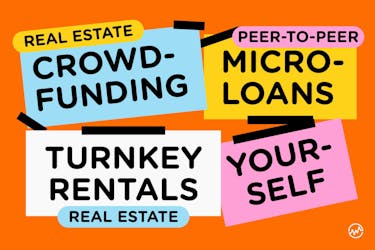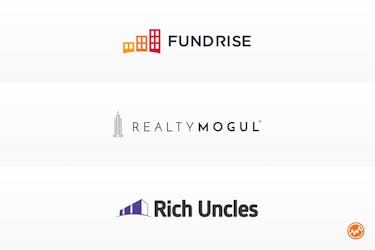
The Ultimate Cashflow & ROI Calculator
In This Article
So you just received a holiday bonus. Or an end-of-year client project that netted a nice profit. Or you’ve already built up your emergency fund and you need an action plan for additional savings in the new year. If you earned an extra $1,000 from any of these scenarios, or a different one, what would you do with it?
It’s a common myth that you need to be “rich” or have a finance degree to be successful at investing.
This isn’t the case.
With the proper knowledge, anyone can invest wisely — including you.
The only difference is that only some people choose to learn how.
It’s tempting to take the easy route and put that extra $1,000 into your savings account. After all, that’s what’s expected of you. That’s what you’ve been taught.
But here’s the problem.
The average savings account interest rate is 0.08% APY — and some of the country’s largest banks pay as little as 0.01% interest.
Even if you luck out and get a savings account with a 0.1% interest rate, in 40 years you will have earned . . . $41.
Yikes!
While that may fill your car up with gas on your morning commute, that’s not worth waiting 40 years for.
High-yield accounts, also known as Certificates of Deposit (CDs), earn interest rates around 1-3%. It’s fine if you know you’ll need access to the money within a specified time frame (like a down payment three years from now), but it’s not too lucrative as a long-term strategy.
After 40 years, you’ll only have doubled your money. While that might sound like a lot, it really isn’t.
What you need to recognize in each of the options listed above is that you’re not even keeping pace with inflation.
You might as well be losing money.
So, what’s a better idea?
In this article, we’re going to break down:
- how to invest 1000 dollars and double it
- where to invest 1000 dollars
- ways to invest 1000 dollars
If you are looking to invest $1,000 outside the traditional stock market (which yields an average rate of return of 9%, but still has volatility), consider one of the following strategies.
How To Invest 1000 Dollars: 4 Ways

Peer-to-Peer Lending/Microloans

Many people lack the resources or the credit to apply for a loan from a bank. Others need smaller amounts of money known as microloans.
Microloans are one of the many ways to invest 1000 dollars. This market gap led to the proliferation of peer-to-peer (P2P) lending platforms, such as LendingClub.com and Prosper.com, which connect potential borrowers with potential investors (like you).
Peer-to-peer lending runs almost exclusively online. Borrowers benefit from a simplified loan application process and more lenient credit requirements.
Investors benefit from lower overhead costs than what they’d pay at traditional banks — which puts higher returns in their pockets.
Investors can browse a variety of loans listed on P2P platforms and choose what to invest in based on 3 things:
- The total amount of the loan
- What it’s being used for
- What rating it is assigned (similar to ratings used for stocks and bonds)

Like with Kickstarter, investors can also check on how much of the loan has already been funded and then buy shares with just the click of a mouse.
According to Prosper.com, the historical average return on the platform is 5.5%, with a range of returns from 3.4 to 9.8%.
As with other investments, yield can be greater than 25% if you are willing to take on more risk.
That’s a lot more than a savings account or a CD.
A lower loan rating means there is a higher risk of default, but also a higher chance of reward.
At Prosper.com, lenders can invest as little as $25 per note.
With a $1,000 investment, that’s 40 notes that can be diversified across different borrowers with varying levels of risk.
One final benefit of microloans?
They are often used to finance entrepreneurs who would otherwise lack the resources to start up their idea.
By investing in microloans, you are also helping entrepreneurs achieve their goals and funding businesses that might have the power to make a big impact on the world.
Real Estate Crowdfunding

Interested in investing in real estate but unsure if you have the necessary funds or time at your disposal?
There is a way to dip your toe in real estate investing and start making the stock market average or better in returns than investing 1000 dollars in real estate.
Online platforms enable you to buy shares in commercial or residential real estate, similar to the crowdsourcing model described in P2P lending:

This type of investing is also known as keeping an electronic Real Estate Investment Trust (eREIT).
Compared to traditional real estate investing, through which you might purchase an entire property for much larger sums, you can build a diversified real estate portfolio with eREITs.
This means that you can invest in everything from single-family homes to larger, more expensive properties like apartment complexes.
There is usually a minimum buy-in for real estate crowdfunding.
At Fundrise and Rich Uncles, you can begin investing with only $500 per share.
That means with $1,000, you can buy a share in two different properties to diversify your real estate portfolio.
You can review and choose which properties to invest in based on their investment ratings and projected returns.
According to Fundrise, the platform’s average annualized returns in 2017 were 11.44%, but they vary depending on the level of risk.
With real estate crowdfunding, you should also determine whether you want to invest in a debt or equity offering.
Equity investment returns are based on a share of the net profits from the property (like rental income), so investing in equity offerings is often better for long-term investors.
Debt investments are based on a fixed interest return, usually from developers who are borrowing the money and paying interest back to investors.
This makes it better for short-term investments.
Many properties also offer a hybrid of the two, so determine your investment goals and choose the property that works best for you and your wallet.
Turnkey Rental Real Estate

Another way to invest 1000 dollars: turnkey real estate. Turnkey real estate offers the financial incentives of being a landlord — without the investor ever needing to deal with tenants or toilets.
Turnkey real estate companies such as Memphis Invest and JWB offer new or renovated properties for investors to purchase. These properties are then rented out to local tenants.
The idea behind turnkey real estate is that the properties are “move-in ready” and will quickly acquire tenants with little to no renovation work needed.

Investors usually hire a management company to handle operations and many do not visit the property while tenants are living there.
Return on investment varies from property to property, but investors can safely expect decent returns.
Investors who buy turnkey real estate receive a rent check every month, which should cover the mortgage and property management — and still provide a steady passive income stream.
Yourself

The best way to invest $1,000?
Yourself!
Remember that old adage about how if you teach a man to fish, it will feed him for a lifetime?
Learning is an investment in your biggest asset: yourself.
Equip yourself with the tools and skills you need for career, business, and investment success so that you will be better prepared to make smart decisions that will pay lifelong dividends.
If you are looking to start a business or achieve financial independence through smart investments, enroll in training courses or pursue a deeper education to fill in your knowledge gaps.
Financial knowledge can help make you a better entrepreneur and investor.
Whether you are a novice or advanced investor, any of these options is a solid alternative to traditional models of saving and investing.
Regardless of what you choose, diversify your portfolio and aim for more than the average ROI.
Continued Learning: How To Invest 1000 Dollars
You don’t have to be “rich” or have a finance degree to be successful at investing.
Now that you know ways to invest 1000 dollars, don’t stop your financial education there.
Learn more about investing and making your money work for you with these additional (and free!) resources:
- Discover how to go from an employee to investor
- How much money do you need to invest in real estate? Find out here
- Choose from one of these stock investing strategies
- Learn how to read a stock in 60 seconds
- Here is a beginner’s guide to investing in oil and gas






